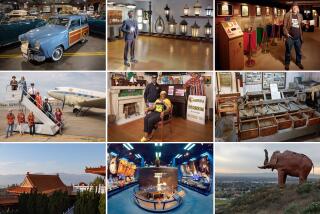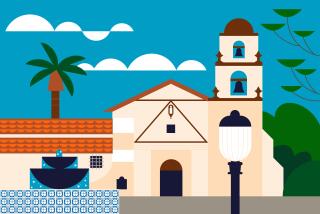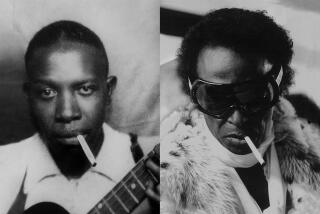His Job Is Catching Up to the Past
- Share via
Did you know that an all-dry town was nearly incorporated in Ventura County a century ago by a Mr. Dunn, who wanted to call it “Duneden”? Eventually, the idea dried up.
Or that A.J. Salisbury, apparently a busy man on the waterfronts, built Port Hueneme Wharf, the Ventura Wharf and Santa Barbara’s Stearns Wharf?
Or that the Oxnard Courier’s premiere issue on Jan. 7, 1899, billed the Oxnard plain as “The greatest bean-producing country on Earth”?
Or that San Buenaventura’s first phone book in 1875 listed 71 working telephones on its one page? The number for the Hobson Bros. Livestock Co. was “2.”
In slightly cramped quarters on the second floor of the Ventura County Museum of History and Art, librarian Charles Johnson offers these and other morsels to the merely curious and to scholars alike.
Johnson, the only paid employee of the museum’s research library, spends his days gleaning facts from such sources as Adolfo Camarillo’s original diaries and an 1869 linen map of Rancho Santa Paula y Saticoy. He also has access to a wealth of information on the late Horace Bristol, obscure clippings on Cesar Chavez and 35,000 old photographs.
Johnson not only collects thousands upon thousands of facts about the county, he also indexes and disseminates them when called upon. If a question concerns Ventura County history, he’s the Answer Man.
“He’s one of the best assets for history we have in this county,” said Richard Senate, who directs historical/cultural tours for the city of Ventura.
“People can have strange requests,” Senate said. “Some go to that library to research the possibility of ghosts in their houses. He handles them all agreeably. He’s very service-oriented. Anyone who goes to that library is in good hands.”
One recent caller asked whether Fatty Arbuckle was born under the Moreton Bay fig tree in Ventura’s Plaza Park. (He was not.)
Then there was a call from a Rutgers University economist who is researching the rate at which various ethnic groups were lent money in Ventura County during the 1800s. The researcher plans to fly to Ventura to peruse surnames in old Bank of A. Levy lending records, which the museum library has on file.
It also has the architectural plans of many public buildings in the county, should anyone be interested.
And someone always is.
“Right now, the hot research topic here seems to be the Japanese-Mexican Labor Assn. at the Oxnard Sugar Beet Factory,” Johnson said. “It is of interest to labor historians.”
The adjective “musty,” commonly applied to endeavors such as research and historical societies, would not fit here.
“Some historical societies are pretty somber; this place is anything but,” Johnson said as he sat at his cluttered desk.
“We are can-do.”
The chairs at the study tables are often filled with chatting amateur and professional researchers eager to share discoveries with each other or a nearby docent.
Sometimes the shared bits of information lead to serendipitous discoveries or connections.
Johnson emphasized how much he leans on the library docents: “Our level of docent support and indexing is unsurpassed. For instance, people come here specifically on Wednesdays for Mary Vanegas’ help on local genealogy. Peggy Watson and Marjorie Olson do the work on clippings and indexing for the prolific early photography of John Brewster.”
Although some of the research topics might seem arcane to many, Johnson revels in recollecting how he and 25 docents spent an entire month, on and off, discussing the difference between a wharf and a pier and what was proper to call the early Port Hueneme and Ventura . . . wharves.
“We decided a wharf is more for commercial use, while a pier tends to be recreational in nature,” he said.
And the quality of the research library’s information literally improves with age.
“The further the subject dates back in time, the better we can do,” Johnson said.
As is often true about repositories such as these, collections of recent decades are the weakest. Pictures, documents and diaries are still in family albums or bureau drawers in people’s homes and have yet to be donated.
“We start getting fuzzy about 1945,” Johnson said. “As far as materials coming out of private collections, there is a 50-year lag.”
The library’s acquisitions budget, which comes from membership dues, is small. That makes private donations all the more important, Johnson said.
“People often don’t know what they have,” he said. “Ninety-nine percent of our collection is donated.”
Asked what he’d like most to acquire for the library’s collection, Johnson admitted his passion is early Pacific Coast business directories.
“I’d love to have more early business directories of Ventura County.”
How more of anything could fit on the already crowded shelves is a puzzle.
Just when he and the docents think they might get the stacks in order, something wonderful happens to put them behind again, such as the recent surprise donation of 4,500 old maps of the county.
He described the windfall as “a typical day,” adding, “that’s why I love my work.”
(BEGIN TEXT OF INFOBOX / INFOGRAPHIC)
FYI
The research library is located at the Ventura County Museum of History and Art, 100 E. Main St., Ventura. It is free and open to the public Tuesday through Friday from 10 a.m.-5 p.m. and Saturday from 10 a.m.-1 p.m. For more information, call 653-0323.
More to Read
The biggest entertainment stories
Get our big stories about Hollywood, film, television, music, arts, culture and more right in your inbox as soon as they publish.
You may occasionally receive promotional content from the Los Angeles Times.










